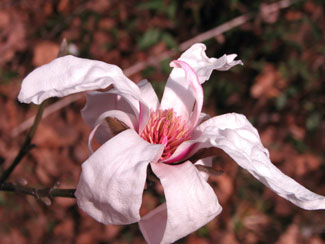Resource Library
Plant of the Week: Magnolia, Zen
Though the Zen magnolia is the earliest blooming of the deciduous magnolias, it is precocious and if well sited likely to escape the vagaries of early spring Arkansas weather. (Image courtesy Gerald Klingaman)
Plant of the Week
Zen Magnolia
Latin: Magnolia zenii
Staring out my office window during this long, harsh winter of discontent I'm anxiously awaiting the swelling buds of the first blooms of spring. My Korean apricot is already in bloom but the big fuzzy blooms of my Zen Magnolia (Magnolia zenii) are not far behind. Though fully three weeks earlier than any of the other deciduous magnolias in my garden, hopefully it will escape the late frosts that plague these early bloomers.
The Zen Magnolia is a deciduous tree growing with an upright pyramidal form eventually reaching heights of 30 feet. Its leaves are to 8 inches long, elliptical in outline and have a respectable yellow-brown fall color in my garden.
The tree is a dependable bloomer, setting abundant terminal flower buds each fall. In the spring, the 5 to 8 inch wide blooms open early, for me usually appearing during the last week of February or the first week of March. This blooming period is about three weeks earlier than my Jane magnolia, which seldom is affected by late spring freezes in my garden. Flowers are pink in bud but open white with the undersurface of the nine tepals marked with a band of purple-pink along the midrib of each tepal. The flowers have a very sweet fragrance unlike most of the other deciduous magnolias I grow.
The Zen Magnolia is new to gardens, first being introduced into the West in 1980 by members of the Sino-American Botanical Expedition, just four years after Chairman Mao's death and the botanical riches of China again became accessible to the gardening world. Though China had been visited by numerous Western plant explorers, this species had escaped notice until 1933 when the Chinese botanist W.C. Cheng found it flowering in isolated stands on Mt. Boa-hua at 600 feet in Jiangsu Province – the coastal province with Shanghai at its southern end. The species is now listed as a critically endangered species in the wild with only a few dozen plants surviving wild in its native habitat. But the “Flora of China” reports it is grown as an ornamental both in China and the rest of the world illustrating another example where gardeners are helping preserve biodiversity.
In the fall of 1980 at the conclusion of their expedition, nine seeds were given to Drs. Steven Spongburg of the Arnold Arboretum at Harvard and Theodore Dudley of the U.S. National Arboretum in Washington D.C. Four Arnold seedlings survived and one tree was planted by their visitor's center where, in 1991 the University of Georgia's Dr. Mike Dirr, in concluding his time as a visiting scholar at the arboretum, collected seeds. A dozen of Dirr's seedlings were planted in an unirrigated field and evaluated until the one with the best flowering and growth form was the lone survivor in the trial planting. In 2001, he introduced this plant as 'Pink Parchment'. Though by no means common, Pink Parchment Zen magnolia is available from magnolia specialists.
An early flowering, frost-prone deciduous magnolia doesn't make much sense for gardeners who want to optimize their chances of having stunning displays each spring. But as a certified plant nerd, I love my Zen magnolia, its interesting story and the fact that it blooms with my forsythia. These early bloomers are true heralds of spring.
Planting early bloomers on a north facing slope, on the north (and thus cool) side of the home or areas that are sheltered from frost will help increase the likelihood of good results. Trees are tough and easy to grow and seem quite adaptable to a wide array of soil conditions. It is winter hardy between zones 6 (5?) and 9. They need at least six hours of sun a day to ensure good blooming. In eight years, my unirrigated tree that is forced to compete with nearby oaks and other shrubs, is about 14 feet tall and reaching the size where it is producing a nice display each spring.
By: Gerald Klingaman, retired
Extension Horticulturist - Ornamentals
Extension News - March 14, 2014
